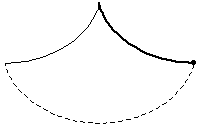Return to computing page for the second course APMA0340
Return to Mathematica tutorial for the second course APMA0340
Return to the main page for the course APMA0330
Return to the main page for the course APMA0340
Return to Part IV of the course APMA0330
Glossary
Period of pendulum oscillations
The time period of the oscillator increases when damping is present. This is because what damping does is essentially it dissipates energy and delays the motion so the time taken to complete one cycle increases slightly. For very high damping ratios (>=1), the system decays or reaches almost zero velocity without oscillating and hence the motion is no longer harmonic (periodic). This is true also because as damping increases or we can say friction increases the particle would try to come back to rest and this will be possible only when it’s time period will also increase.
In case of forced oscillations, period of oscillation does not depend on the damping force and is equal to frequency of driving force. The damping force only reduces the amplitude of oscillation at resonance and creates a lagging response. If the driving force is suddenly switched off at resonant frequency , the oscillation amplitude will decay exponentially at the oscillation frequency less than resonant frequency due to the damping effect . On further increasing the damping constant above a critical value oscillation stops completely and response becomes purely exponentially decaying. System is then called critically damped. Such transition from oscillatory response to exponential hints at the deeper connection between cosine and exponential functions. No wonder why complex number aided by remarkable Euler's formula acts as two way bridge between these functions and facilitates an easy mathematical solution to oscillation problems. The differentiation operation is reduced to ordinary multiplication operation by use of complex exponential functions.
Example:

Example: The Toda lattice models particles on a line interacting with pairwise exponential forces and is governed by the Hamiltonian:
periodicRule = q[n+1,t] -> q[1,t];
H = Sum[p[k,t]^2 /2 + Exp[q[k+1,t] - q[k,t]] -1, {k,1,n}]; eigenvalueRule = {a[k_,t_] :> -p[k,t]/2, b[k_,t_]:> 1/2 * Exp[q[k+1,t]-q[k,t]]};
L={{a[1,t],b[1,t], b[3,t]}, {b[1,t], a[2,t], b[2,t]}, {b[3,t], b[2,t], a[1,t]}}/.eigenvalueRule;
RuleDelayed (:> or :->) command that represents a rule that transforms lhs to rhs, evaluating rhs only after the rule is used.
Evaluate the StepMonitor expression separately each time it is to be used:
- Bennett, M., Schatz, M.F., Rockwood, H., and Wiesenfeld, K., Huygens’ clocks, Proceedings: Mathematical, Physical and Engineering Sciences Vol. 458, No. 2019 (Mar. 8, 2002), pp. 563-579 (17 pages); doi: 10.1098/rspa.2001.0888
- Huygens, C., The pendulum clock, Part 4: On the center of oscillation, translated by Michael S. Mahoney, 1995.
- Ramirez, J.P., Olvera, L.A., Nijmeijer, H., Alvarez, J., The sympathy of two pendulum clocks: beyond Huygens’ observations, Scientific Reports, 2016, March, Article number: 23580. https://doi.org/10.1038/srep23580
- Willms, A.R., Kitanov, P.M., Langford, W.F., Huygens’ clocks revisited, The Royal Society, Open Science, 2017.
Return to Mathematica page
Return to the main page (APMA0330)
Return to the Part 1 (Plotting)
Return to the Part 2 (First Order ODEs)
Return to the Part 3 (Numerical Methods)
Return to the Part 4 (Second and Higher Order ODEs)
Return to the Part 5 (Series and Recurrences)
Return to the Part 6 (Laplace Transform)
Return to the Part 7 (Boundary Value Problems)